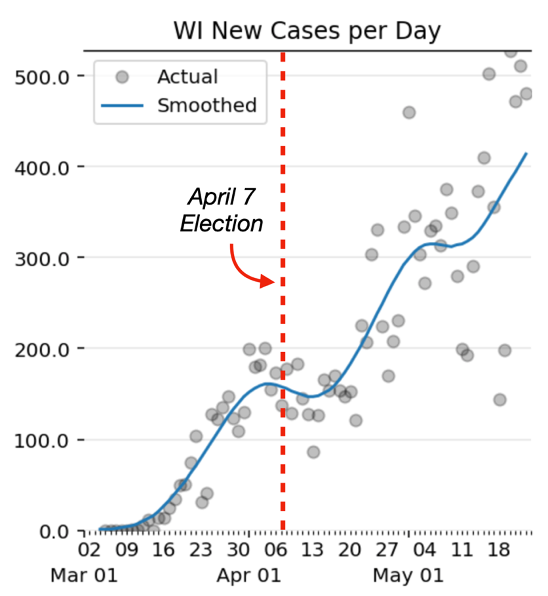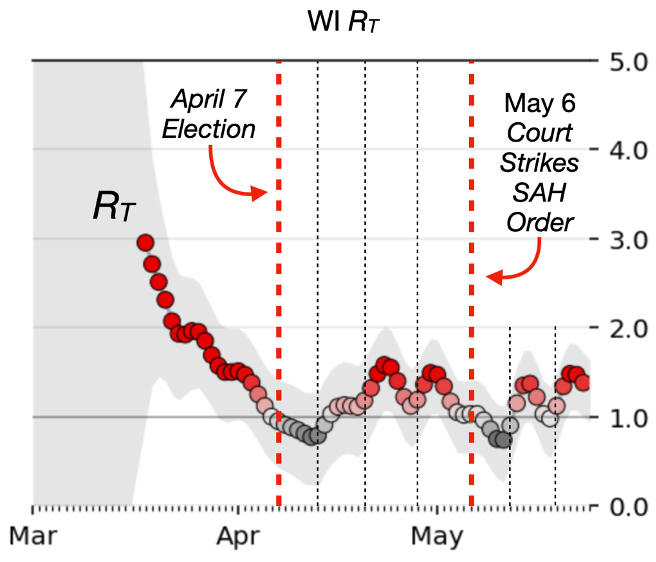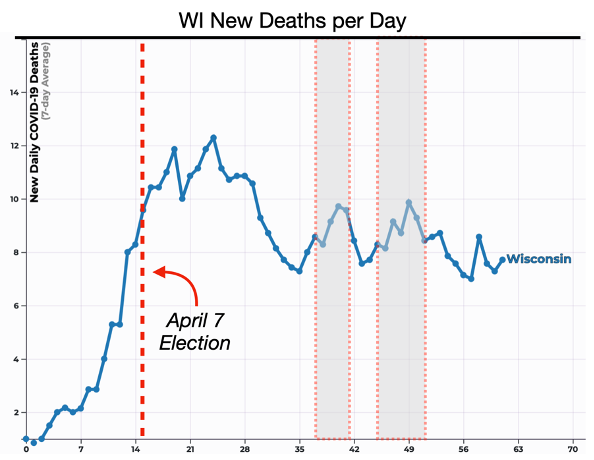Yves here. Correlation is not causation, but the Wisconsin primary looks to have ushered in more Covid-19 infections.
By Phillip Alvelda. Originally published at the Institute for New Economic Thinking website
The world is on edge at the prospect of a resurgent wave of infections. Models and speculation are rife, but facts remain scarce, which is why the events in Wisconsin on April 7, and their eventual impact, are so important.
As COVID-19 advanced across the globe, most countries reacted by instituting shelter-in-place and lock-down strategies. As those curbs now begin to ease, the world is on edge at the prospect of a resurgent wave of infections. Models and speculation are rife, but facts remain scarce.
Which is why the events in Wisconsin on April 7, and their eventual impact, are so important.
On that day, citizens who wished to exercise their right to vote in the state’s political primary were forced to go in person to the polls. Strong opposition and a series of court rulings had foreclosed earlier hopes for conducting the primary entirely by mail. In hindsight, the events in Wisconsin clearly demonstrate the outcome of a deliberate one-day easing of social distancing practices—and this grim picture may be worth more than a thousand words of speculation and modeling.
A straightforward statistical and graphical analysis of Wisconsin’s COVID-19 daily confirmed new cases and death counts show a clear surge in both, with lags characteristic of the independently measured course of the Coronavirus. The deadly cycle typically takes between twenty-two and twenty-six days from the first signs of infection, to hospitalization, through the intensive care unit, and too often, to death.
As Figure 1, based on data from the Wisconsin Department of Health[1], reveals, a cascade of new cases in the period following the April 7 in-person election is apparent. The grey circle markers show the daily count of new confirmed COVID-19 infections in Wisconsin by date. The blue line is a smoothed average of the new case count that highlights trends over time.
Figure 1

Source: Wisconsin State Department of Health data.
Figure 2 offers more detail on this surge. It shows daily estimates of the COVID-19 “effective” reproductive number (Rt ), which is the virus’s transmission rate, on any given date.[2] Put simply, Rt is the number of people a single COVID-19-positive patient would likely infect on that date. If Rt is greater than one (represented in red), the virus is spreading exponentially. If Rt is less than one (represented in grey), it is being suppressed. This measure reflects the effectiveness (or lack thereof) of any social distancing, sheltering, or other abatement measures on the growth or suppression of the virus.
Figure 2

Source: See text
Figure 2 above shows a measurable resurgence of the virus within six days of the in-person April 7, 2020 primary election vote. This surge is tightly synchronized with the expected up-tick from the independently measured and published incubation period of COVID-19 (marked by the vertical black dashed lines). The pattern is repeated within fourteen days and again at 22 days after the election, consistent with the people first infected on the 7th going on to infect subsequent sets of people, with additional new generations of infected each 5-7 days. Only after the third surge of infections, three weeks after the election, do the distancing and sheltering orders finally resume dampening the resurgence of the virus. A similar pattern can be seen following the Wisconsin Supreme Court’s action to strike down the Wisconsin governor’s stay-at-home orders on May 6, with cases now, once again, resurgent.
Figure 3 below depicts the daily count of new confirmed COVID-19 deaths in Wisconsin by date[3], smoothed to display a 7-day moving average to highlight trends. Here again, surges in the number of deaths occur at intervals consistent with usual course of COVID-19 treatment and mortality. The COVID-19 median time interval from infection to symptoms (or serial interval) is 5-7 days[4] and then from symptom development to death is 16.9–19.2 days.[5],[6] Using this data independently sampled from Wuhan, Lombardy, and NY, patient deaths from those infected on April 7 would be expected to peak exactly within the grey-shaded time intervals.
Figure 3

References and Notes
[1] Daily New Case data is from the Wisconsin Department of Health Services, https://www.dhs.wisconsin.gov/outbreaks/index.htm; accessed May 23, 2020.
[2] The real-time Rt estimates were calculated through Bayesian statistical analysis of the data in Figure 1: WI New Cases per Day. Uncertainty in the measure is reflected by the grey-shaded area that spans the 90% confidence interval of the Rtestimate. (In other words, there is a 90% chance that the actual Rt is within the grey-shaded area, with the most likely value at the red/grey markers).
[3] Daily death count data was sourced from Johns Hopkins CSSE, https://systems.jhu.edu/research/public-health/ncov/, and updated May 22, 2020.
[4] Du Z, Xu X, Wu Y, Wang L, Cowling BJ, Meyers L. Serial Interval of COVID-19 among Publicly Reported Confirmed Cases. Emerg Infect Dis. 2020;26(6):1341-1343. https://dx.doi.org/10.3201/eid2606.200357
[5] Yang X, Yu Y, Xu J, Shu H, Xia J, Liu H, et al. Clinical course and outcomes of critically ill patients with SARS-CoV-2 pneumonia in Wuhan, China: a single-centered, retrospective, observational study. Lancet Respir Med. 2020;S2213-2600(20)30079-5 https://www.thelancet.com/journals/lanres/article/PIIS2213-2600(20)30079-5/fulltext
[6] Verity R, Okell L, Dorigatti I, Winskill P, Whittaker C, Imai N, et al. Estimates of the severity of coronavirus disease 2019: a model-based analysis. The Lancet March 30, 2020. https://doi.org/10.1016/S1473-3099(20)30243-7


If I am reading the chart that displays deaths correctly it doesn’t match the Wisconsin Department of Health website. The authors say they use the Johns Hopkins data which appears to be different, why? The chart appears to say about 8 people died on April 7th. The WI DHS says 15 people died on April 7th.
https://www.dhs.wisconsin.gov/covid-19/deaths.htm
All the WI data can be downloaded here: https://data.dhsgis.wi.gov/datasets/covid-19-historical-data-table/data?page=3&where=GEO%20%3D%20%27State%27 and it is quite detailed.
A good hypothesis would be that people got infected that day when they clustered together to vote in person. About 850,000 people voted in person? They say they got back 1,003,422 absentee ballots. Total votes for president was 1,850,130.
In the bigger picture even using the articles data, it doesn’t appear that many people got it from that fairly large (but dispersed?) event.
However, now knowing several people who have gotten it and survived, it was a miserable experience. High fever for 5 days with little ability to sleep, 4 days of receding sickness followed by being so weak it seems like you have mono is how it was described to me.
The Republican behavior isn’t very surprising given their record, but the Democratic party should have simply cancelled this primary. Biden refused to do this.
Sorry. ANYONE who risked their life to vote for Bernie vs, Biden is an idiot. It really isn’t that important.
That is a separate issue. The primary should have been postponed for safety reasons or conducted only with mail-in ballots or in some other novel way that doesn’t risk public health.
Your flippant comment reveals your ignorance. Biden vs. Sanders was not the burning issue on that ballot. The burning issue was about a vacancy on the WI Supreme Court. The Reps were trying to pack it with right wing justices, not unlike Mitch McConnell’s life goal with SCOTUS. I would say that’s a reason to come out and vote!
Only my opinion, but it would also seem the double peak about a week apart would also possible be due to the Easter holiday weekend that followed the primary.
The shadow of Governor Scott Walker still has a lasting effect in the State of Wisconsin. The deciding vote (4-3) to strike down the Stay-At-Home order was by Daniel Kelly, who had recently lost his bid for re-election to Jill Karofsky. So he did this on his way out the door. And Daniel Kelly was a Scott Walker appointee and if you read his Wikipedia entry, you can understand why he would have appealed to Walker as a judge-
https://en.wikipedia.org/wiki/Daniel_Kelly_(Wisconsin_judge)
And it is the people of Wisconsin that are paying the price for these lethal judgements.
So I guess it is important whom one votes for. Ramifications.
Weren’t all 4 of them deciding votes? There was no swing voter. Any chance of throwing out the other 3 next election?
The Wisconsin court is set up so that you can only have one judge elected for every year so as not to change the composition of that court radically. To change the other three you would need three more years to do so-
https://en.wikipedia.org/wiki/Wisconsin_Supreme_Court#Elections
Who was it that said: There are three kinds of lies–lies, damned lies, and statistics!
jonswift: Samuel Clemens (Mark Twain)
It was also Mark Twain, who claimed that the key thing in getting to be important was publicity and to keep your name simple and short. He also said that any publicity is good because it helps people to remember your name and bad publicity doesn’t matter as long as they spell your name right. Hence we have TRUMP/TWAIN and Trump in big letters on buildings all over the world, although most he doesn’t actually own. Just like Twain in his day , his name became a brand and people recognized it, especially on a list of lesser known candidates when in the voting booth. BIDEN also has that kind of a name, but every effort has been made to keep it from becoming a brand. There are no BIDEN hotels, golf courses, Hollywood associations or glamor. While Biden was busy legislating, Trump was busy running the Miss Universe contest. More working class people remember who won those contests than can remember any important bills that Biden supported and helped to improve their lives.
The Wisconsin Supreme Court decision to terminate stay-at-home orders was on May 13, not May 6 as you have stated here.